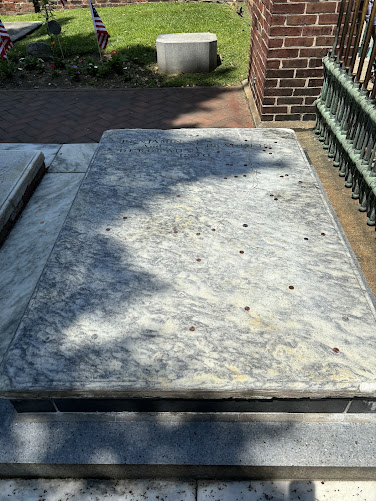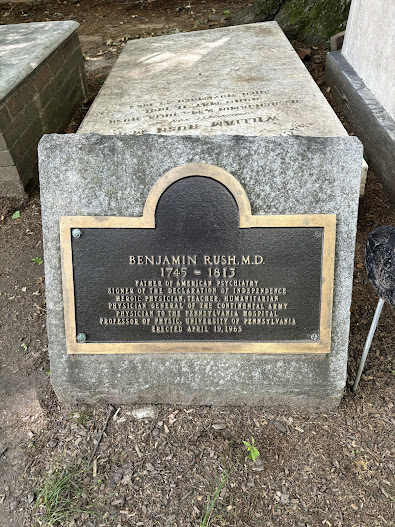We still had a lot to see and we wasted no time. First stop was Christ Church and the Burial Ground. Christ Church was founded in 1695 by members of the Church of England who built a small wooden church on the site by the next year. The church served as a place of worship for many of the most notable participants in the American Revolution, including George Washington.
The current building, dating to 1744, has been cited as "our finest Early American church" and one of the finest Georgian structures in America. The steeple, from 1754, was financed by a lottery organized by Benjamin Franklin. For 56 years the steeple made Christ Church the tallest structure in North America.
Outside the church were two signers of the Declaration of Independence.
Robert Morris
The inside of the church is beautiful.
The baptismal font in which William Penn was baptized is still in use today; it was sent to Philadelphia in 1697 from All Hallows-by-the-Tower in London where William Penn was baptized as an infant.
Brass plaques mark the pews where revolutionary individuals once sat. This is the pew where Betsy Ross sat after she had been read out (asked to leave) of the Quaker meeting house to which she belonged for marrying John Ross, son of an assistant rector at Christ Church. You can see the baptismal font in the background in the top right corner.
Inside were "slabs" designating the burial site of early worshippers.
This one was interesting.
John Penn was the eldest son of Richard Penn and Hannah Lardner. Richard had inherited a one-fourth interest in the Pennsylvania proprietorship from his father, Pennsylvania founder William Penn. Richard's older brother, Thomas Penn, controlled the other three-fourths of the proprietorship. As Thomas did not have any sons while John Penn was in his youth, the young man was in line to inherit the entire proprietorship, one-fourth from his father and three-fourths from his paternal uncle. John Penn served as the last governor of colonial Pennsylvania, serving in that office from 1763 to 1771 and from 1773 to 1776.
A few blocks down the street is the Christ Church Burial Ground, an active cemetery today. There is a small fee to enter the grounds, weather permitting, and attracts about 100,000 tourists per year.
The two acres, which is now in Old City Philadelphia, was in the "suburbs" when Christ Church purchased it in 1719. The church was running out of room in its graveyard, and members wanted to move new burials to the outskirts of the city. Burials began almost immediately with the earliest tombstone dating back to 1720.
The most "famous" grave is that of Benjamin Franklin. This brick post is on the sidewalk outside the cemetery - note the graves on the other side of the fence. The rails were added for public viewing in 1858 by parties working at the behest of the Franklin Institute, which assumed the responsibility of defending Franklin's historic ties to Philadelphia after prominent Bostonians criticized the city's maintenance of the grave.
Benjamin and Deborah (Read) Franklin on the right
Leaving pennies on Franklin's grave is an old Philadelphia tradition which originated from his statement "a penny saved is a penny earned". We overheard a tour guide tell a group of people that they collect about $4,000 per year which they donate to charity.
Next to Benjamin and Deborah is their only daughter, Sarah Franklin Bache (1743-1808) and her husband, Richard Bache Sr. (1737-1811).
Besides Benjamin Franklin, this was an opportunity to see additional signers These men were all incredibly brave - this is a stone we saw as we visited a signer in another state which I will discuss later.
Also, some of the wives are interred here.
Phew, we were exhausted but still had more to see. But we took time to have a Philadelphia staple.
Ambrose and Rose Campo probably never imagined that the little grocery store and butcher shop they based their lives on in 1947 would still be here today....successful, growing, and continuing the traditions and values on which their future flourished. The location has moved over the years but the family still runs the shop - we met their delightful granddaughter, Mia.
We ordered the "Philly way" - one cheesesteak wit and one witout. (That's one with onions, one without.) And a side of pasta salad to share. Yum!
The day was getting away from us and we had a long, hot walk back to the truck. Thankfully, our last stops were on the way to the parking lot.
The Betsy Ross house. There has been debate as to whether Betsy actually sewed the first flag and historians have discussed this for over two hundred years. I'll leave the truth of the story to them but the records show that on May 29, 1777, the Pennsylvania State Navy Board paid her a notable sum for her work making American flags. Although this doesn't necessarily mean she sewed the first flag, it's clear she was involved in making early American flags.
We had to move on so we just took a few minutes to sit in the shade and skipped the tour.
Thomas Jefferson resided here while drafting the Declaration of Independence. Demolished in 1883, the house was reconstructed by the National Park Service in 1975.
And finally, our last stop.
It's hard to see the detail but it's interesting to see how the neighborhood changed over the years.
This gave me goosebumps as we walked through the passage.
Part of the neighborhood has been utilized as a museum. Some interesting items on display.
This is the last known life portrait of Franklin, painted when he was 79, serving as President of the Supreme Executive Council of Pennsylvania. He is shown wearing the bifocals he invented the year before. (The image is reproduced from the oil on canvas portrait in the Pennsylvania Academy of Fine Arts in Philadelphia.)
Portrait by Charles Willson Peale, 1785
This painting, Congress Voting Independence, is thought to realistically depict the historic vote for independence. Jefferson is the tall man holding the Declaration of Independence. Franklin is seated in the front to Jefferson's right.
Robert Edge Pine and finished by Edward Savage, 1784-1801
Franklin admired the work of the English printer, John Baskerville. He bought this Bible in England for his daughter, Sarah, inscribing it to her on the title page. It descended in the family of Sarah's daughter, Deborah.
This painting is a copy by Benjamin Wilson of his portrait of Franklin that was stolen from the Franklin's Philadelphia dining room during the Revolutionary War. The stolen portrait was taken by a British officer and remained in England until it was returned to the United States in 1906.
Portrait by Benjamin Wilson, original c. 1760
And now it was time to stumble back to the truck!





































Did you watch the miniseries Franklin starring Michael Douglas? It was quite fascinating.
ReplyDeleteLooks interesting but we don't have Apple :-(
DeleteYou can probably get a free trial for seven days and watch it. Or at worst sign up for a month and then cancel.
ReplyDeleteI would do that if we had reliable WiFi but, sadly, that's not the case.
Delete